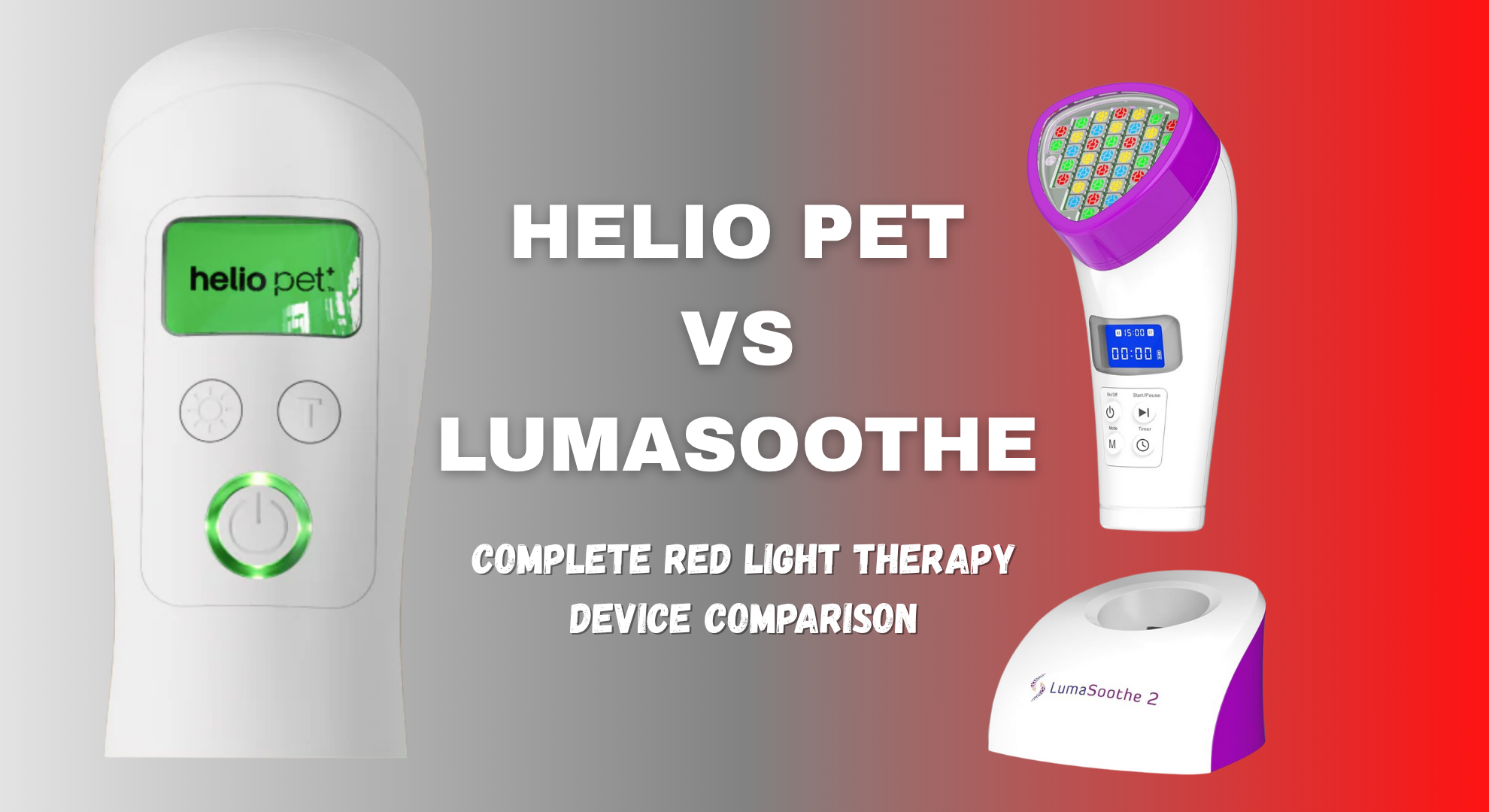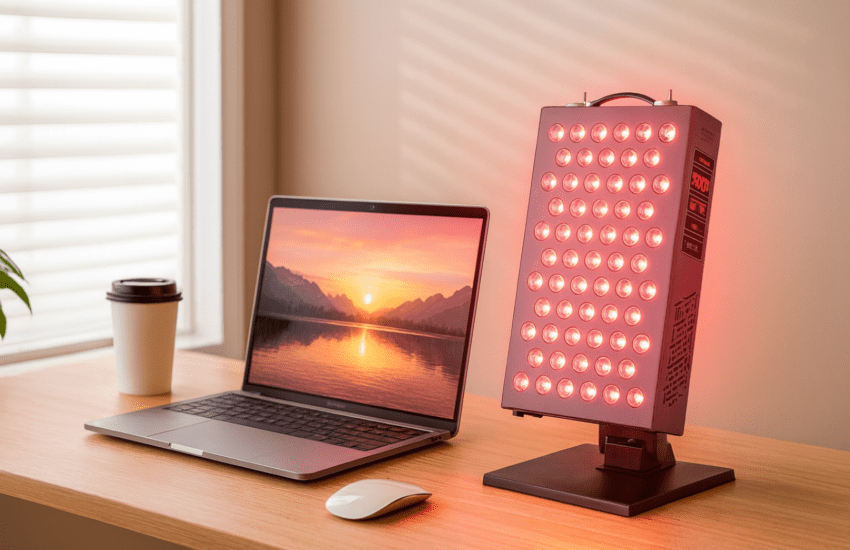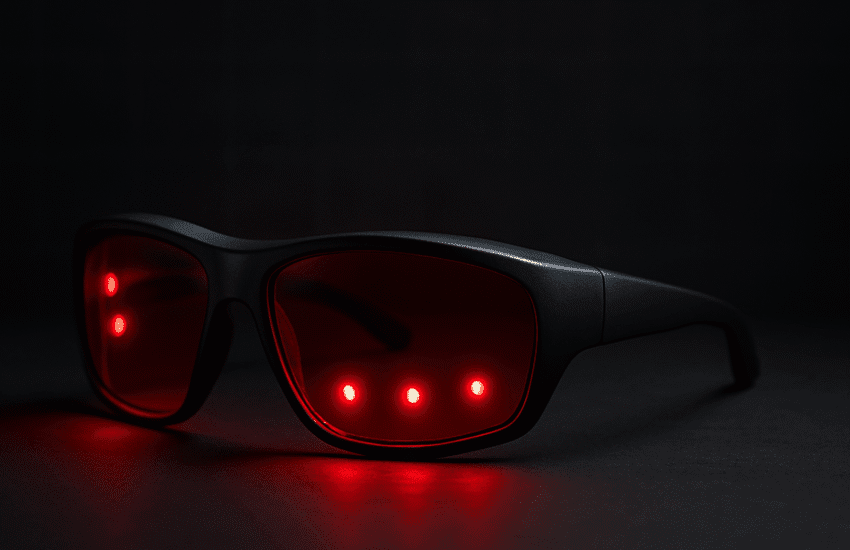Helio Pet vs LumaSoothe: Which Red Light Therapy Device Is Best for Your Pet in 2025?
At a Glance: Helio Pet Pro delivers broader coverage and higher power output, ideal for large treatment areas and widespread conditions. LumaSoothe (available on Amazon) offers precise targeting with a compact design and multiple wavelengths, better suited for localized treatments and comprehensive therapy.
Light therapy, also known as photobiomodulation, uses specific wavelengths of red and near-infrared light to stimulate cellular energy production, reduce inflammation, and promote healing in our animal companions.
Both Helio Pet and LumaSoothe are RLT devices that offer alternative treatment options for various pet health conditions, but they serve different needs based on your pet’s size and condition type.
Helio Pet Pro vs LumaSoothe 2: Key Differences at a Glance
| Specification | Helio Pet Pro | LumaSoothe 2 |
|---|---|---|
| Red Light Wavelength | 660nm | 650nm |
| Near-Infrared Wavelength | 850nm | 940nm |
| Additional Wavelengths | None | Green (520nm), Blue (470nm), Yellow (590nm) |
| Power Output | Higher intensity | Moderate intensity |
| Treatment Coverage | Large area (4+ inches) | Focused beam (2 inches) |
| Best For | Large dogs, multiple areas | All pets, targeted treatment |
Disclosure: As an Amazon Associate I may earn from qualifying purchases at no extra cost to you.
Light Wavelengths & Power Output: How Each Device Works
Helio Pet Pro: 660nm + 850nm for Deep and Surface-Level Relief
Helio Pet uses 660nm red light for surface treatments like skin conditions and wounds, and 850nm near-infrared light for deeper tissue penetration in joints and muscles.
LumaSoothe 2: Multiple Wavelengths for Comprehensive Therapy
LumaSoothe 2 features 5 Wavelengths of Low Level Light Therapy (Infrared, Red, Green, Blue and Yellow), combining them into one treatment head with two distinct treatment modes. The specific wavelengths are:
- Surface Treatment Mode: Red 650nm, Green 520nm, Blue 470nm, and Yellow 590nm
- Deep Treatment Mode: Infrared 940nm, Red 650nm, and Green 520nm
The 650nm wavelength falls within the red light spectrum and has been found to be optimal for skin rejuvenation and wound healing.
The infrared wavelength can penetrate even deeper into tissues, potentially offering better results for conditions like arthritis and deep muscle pain.
Power Output Comparison: Higher Isn’t Always Better
The ideal intensity depends on your pet’s size, the area being treated, and the specific condition you’re addressing.
Helio Pet delivers higher power with 5 powerful diodes, making it well-suited for large dogs, thicker coats, and deeper tissue issues like hip dysplasia. However, that extra intensity requires careful timing to avoid overexposure.
LumaSoothe 2 features a smaller 2-inch treatment head with two distinct treatment modes that allow you to choose between deep tissue treatment and surface treatment depending on your pet’s specific needs.
Treatment Coverage: Large Area vs Targeted Application
Helio Pet’s larger treatment head is 3x larger than other standard devices, covering four to six inches per application, making it efficient for treating extensive conditions or multiple affected areas simultaneously.
This broad coverage works well for large breed dogs with widespread arthritis, extensive skin conditions, or large surgical sites.
LumaSoothe 2’s compact design focuses light into a precise two-inch treatment area, ideal for localized joint pain, small wounds, facial treatments, or conditions near sensitive areas like eyes and ears.
The precision targeting reduces unnecessary light exposure while ensuring adequate therapeutic dose delivery.
While this requires more time to treat larger areas, the precision targeting ensures adequate therapeutic dose delivery and the 5-wavelength approach provides comprehensive therapy options.
Ease of Use: Which Device Is More Pet-Friendly?
Not all pets willingly sit still for light therapy sessions, making device user-friendliness crucial for successful treatments. Pet cooperation often determines treatment success more than device specifications alone.
Helio Pet features silent operation and combines cold laser therapy technology with a specially designed prism for heat reduction, ensuring a cool and safe light treatment. The device includes preset treatment programs for various conditions, removing guesswork from treatment protocols for beginners.
LumaSoothe 2 is small, ergonomic, weighs only 144.5 grams (5.1oz) and fits perfectly in the palm of your hand. Its lightweight construction makes it comfortable to hold during extended treatment sessions, particularly useful when targeting hard-to-reach areas.
The LumaSoothe device also uses pulsating light therapy technology rather than a constant beam of light for effectiveness, providing automatic treatment intervals with built-in timer functionality.
How to Choose Between Helio Pet and LumaSoothe
Choose Helio Pet If Your Pet Has:
- Large size
- Multiple problem areas or widespread conditions
- Thick coat requiring deeper light penetration
- Need for treating several pets with one device
Where to Buy: Available on the official Helio Pet website.
Choose LumaSoothe If Your Pet Has:
- Localized issues requiring targeted treatment
- Need for multiple wavelength therapy (5 wavelengths)
- Preference for portable, lightweight device
- Conditions requiring both deep and surface treatment modes
Where to Buy: LumaSoothe is available on Amazon.
Safety Guidelines for Pet Red Light Therapy
Both devices include protective eyewear and safety instructions. Eye protection is essential during treatment sessions to prevent retinal damage. These devices also feature automatic shut-off timers to prevent overexposure.
Avoid treatment in pregnant animals without veterinary approval, areas with active cancer, or pets taking photosensitizing medications. Start with 5-10 minute sessions to assess pet tolerance before progressing to full therapeutic protocols.
For a deeper breakdown of potential risks, recommended session lengths, and when to avoid treatment, see our full guide on red light therapy safety for pets.
Real-World Benefits of Pet Red Light Therapy
Arthritis and Joint Pain Management
A 2022 randomized, controlled trial published in the American Journal of Veterinary Research compared photobiomodulation therapy with standard medication in dogs with hip osteoarthritis. Dogs receiving light therapy showed lasting improvements in pain levels, mobility, gait, and joint function—some benefits were still evident 90 days after treatment ended
Wound Healing and Surgical Recovery
A 2016 clinical study in the Journal of Veterinary Clinical Practice and Petcare observed better healing of surgical wounds in dogs treated with photobiomodulation versus untreated controls.
Skin Conditions and Inflammation
Veterinary reviews suggest that red light therapy can improve skin health by boosting collagen production, supporting blood flow, strengthening the immune response, and reducing inflammation.
While there are fewer clinical trials focused specifically on pets, these findings point to potential benefits for treating skin issues like dermatitis and hot spots.
Final Recommendation: Which Device Is Right for Your Pet?
Both Helio Pet and LumaSoothe offer promising benefits for pet health through light therapy. Your choice between the two will likely come down to your specific pet’s needs, your budget, and personal preferences.
Helio Pet’s larger treatment head and higher power output make it ideal for larger pets or those with many or extensive treatment areas. It’s particularly well-suited for dogs with arthritis or widespread skin conditions.
LumaSoothe’s compact design and more focused beam make it perfect for smaller pets, targeted treatments, or those who need a more portable option. It excels in treating localized issues and can be less intimidating for nervous animals.
Whichever device you choose, you’re taking a positive step towards supporting your pet’s health and well-being. Remember to ask with your veterinarian, start slowly, and pay close attention to your pet’s responses.
With patience and consistency, light therapy can become a valuable tool in your pet care arsenal.
FAQs: Pet Red Light Therapy Explained
What is pet light therapy?
Pet light therapy, also known as photobiomodulation, uses specific wavelengths of red and near-infrared light to stimulate cellular energy production, reduce inflammation, and promote healing in animals.
How does light therapy help dogs with arthritis?
Light therapy can help dogs with arthritis by reducing inflammation, increasing blood flow to affected areas, and stimulating the production of ATP (cellular energy), which can lead to decreased pain and improved mobility.
Can light therapy help with my cat’s skin problems?
Yes, light therapy can be useful for various cat skin problems. It can help reduce inflammation, promote healing of wounds or lesions, and stimulate collagen production, which can improve overall skin health.
How often should I use light therapy on my pet?
The frequency of light therapy treatments depends on the condition being treated and your pet’s person needs. Generally, treatments are done 3-7 times per week initially, then reduced as improvement is seen. Always follow the manufacturer’s guidelines and ask with your veterinarian.
Is light therapy safe for all pets?
Light therapy is generally considered safe for most pets when used as directed. However, it’s important to ask with your veterinarian before starting any new treatment, especially if your pet has any pre-existing conditions or is taking medications.
Can light therapy help with my dog’s wound healing?
Yes, light therapy can speed up wound healing in dogs by stimulating cellular energy production, increasing blood flow to the affected area, and reducing inflammation. This can lead to faster healing and reduced scarring.
How long does a typical light therapy session last for pets?
The duration of a light therapy session can vary depending on the device, the condition being treated, and the size of the treatment area. Typically, sessions range from 5 to 30 minutes.
Always follow the manufacturer’s recommendations for your specific device.
Can light therapy help reduce anxiety in pets?
While more research is needed, many pet owners report improvements in their animals’ overall well-being and stress levels after consistent use of light therapy. The gentle warmth and soothing light may have a calming effect on some pets.
Is light therapy effective for older pets with chronic conditions?
Light therapy can be particularly useful for older pets with chronic conditions such as arthritis or muscle stiffness. It can help manage pain, reduce inflammation, and improve mobility, potentially enhancing quality of life for senior pets.
Can I use a human light therapy device on my pet?
It’s generally not recommended to use human light therapy devices on pets. Pet-specific devices are designed with suitable wavelengths, power outputs, and safety features for animal use.
Always use devices specifically designed and approved for pet use.
Medical Disclaimer: This article is for informational purposes only and is not intended as veterinary medical advice. Light therapy devices should not replace professional veterinary care. Always consult with a qualified veterinarian before starting any new treatment for your pet, especially if your pet has existing health conditions, is pregnant, or is taking medications. Individual results may vary, and what works for one pet may not work for another.


